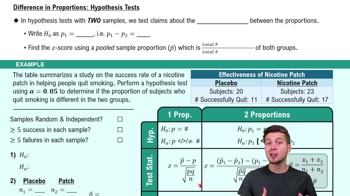Here are the essential concepts you must grasp in order to answer the question correctly.
Simple Random Sample
A simple random sample is a subset of individuals chosen from a larger population, where each individual has an equal chance of being selected. This method ensures that the sample is representative of the population, minimizing bias and allowing for valid statistical inferences. In this context, the sample of 1020 adults provides a basis for analyzing the self-assessment of driving skills among the general adult population.
Recommended video:
Sampling Distribution of Sample Proportion
Proportion
A proportion is a statistical measure that represents the part of a whole, expressed as a fraction or percentage. In this case, 86% of the respondents rated themselves as above average drivers, which can be converted into a proportion by dividing the number of respondents who rated themselves as such by the total number of respondents. Understanding proportions is essential for interpreting survey results and making comparisons.
Recommended video:
Difference in Proportions: Hypothesis Tests
Hypothesis Testing
Hypothesis testing is a statistical method used to determine whether there is enough evidence to support a specific claim about a population parameter. In this scenario, the claim is that more than 3/4 (or 75%) of adults consider themselves above average drivers. By conducting a hypothesis test, we can evaluate this claim using the sample data and assess whether the observed proportion significantly exceeds the hypothesized value.
Recommended video:






